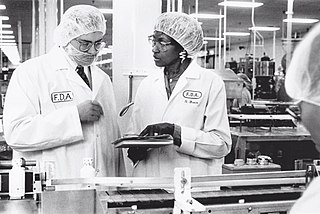A chemical database is a database specifically designed to store chemical information. This information is about chemical and crystal structures, spectra, reactions and syntheses, and thermophysical data.

The pharmaceutical industry discovers, develops, produces, and markets pharmaceutical drugs for the use as medications to be administered to patients, with the aim to cure and prevent diseases, or alleviate symptoms. Pharmaceutical companies may deal in generic or brand medications and medical devices. They are subject to a variety of laws and regulations that govern the patenting, testing, safety, efficacy using drug testing and marketing of drugs. The global pharmaceuticals market produced treatments worth $1,228.45 billion in 2020 and showed a compound annual growth rate (CAGR) of 1.8%.
Cheminformatics refers to the use of physical chemistry theory with computer and information science techniques—so called "in silico" techniques—in application to a range of descriptive and prescriptive problems in the field of chemistry, including in its applications to biology and related molecular fields. Such in silico techniques are used, for example, by pharmaceutical companies and in academic settings to aid and inform the process of drug discovery, for instance in the design of well-defined combinatorial libraries of synthetic compounds, or to assist in structure-based drug design. The methods can also be used in chemical and allied industries, and such fields as environmental science and pharmacology, where chemical processes are involved or studied.
The DrugBank database is a comprehensive, freely accessible, online database containing information on drugs and drug targets created and maintained by the University of Alberta and The Metabolomics Innovation Centre located in Alberta, Canada. As both a bioinformatics and a cheminformatics resource, DrugBank combines detailed drug data with comprehensive drug target information. DrugBank has used content from Wikipedia; Wikipedia also often links to Drugbank, posing potential circular reporting issues.
ChemSpider is a freely accessible online database of chemicals owned by the Royal Society of Chemistry. It contains information on more than 100 million molecules from over 270 data sources, each of them receiving a unique identifier called ChemSpider Identifier.
Chemaxon is a cheminformatics and bioinformatics software development company, headquartered in Budapest with 250 employees. The company also has offices in Cambridge, San Diego, Basel and in Prague. and it has distributors in China, India, Japan, South Korea, Singapore, and Australia.
PainCeptor Pharma is a private Canadian company focused on the development of drugs that act outside the central nervous system on nociceptors to treat pain. The company was established in 2004 through the merger of two academic spinout firms: Antalium from McGill University and NeuroCeptor from Queens University. At its inception, the company's primary operations were in Montreal and Kingston, and it established a partnership with the Danish company NeuroSearch as part of its birth.

TopoTarget was a Copenhagen-based biotechnology company focused on the discovery and development of drugs and therapies to treat cancer. In 2014, it merged with BioAlliance Pharma and is now part of Onxeo.
Christoph Westphal is an American biomedical businessman.
Computational Resources for Drug Discovery (CRDD) is one of the important silico modules of Open Source for Drug Discovery (OSDD). The CRDD web portal provides computer resources related to drug discovery on a single platform. It provides computational resources for researchers in computer-aided drug design, a discussion forum, and resources to maintain a wiki related to drug discovery, predict inhibitors, and predict the ADME-Tox property of molecules. One of the major objectives of CRDD is to promote open source software in the field of chemoinformatics and pharmacoinformatics.
Santaris Pharma A/S was a biopharmaceutical company founded in 2003 in Copenhagen, Denmark. The company also had a branch in San Diego, California that opened in 2009. Created by a merger between Cureon and Pantheco, Santaris developed RNA-targeted medicines using a Locked Nucleic Acid (LNA) Drug Platform and Drug Development Engine.

Antony John Williams is a British chemist and expert in the fields of both nuclear magnetic resonance (NMR) spectroscopy and cheminformatics at the United States Environmental Protection Agency. He is the founder of the ChemSpider website that was purchased by the Royal Society of Chemistry in May 2009. He is a science blogger and an author.

Evotec SE is a publicly listed drug discovery and development company headquartered in Hamburg, Germany. The company operates globally, largely through external alliances with pharmaceutical and biotechnology companies, academic institutions, patient advocacy groups, and venture capitalists. As of 31 December 2021 Evotec had a market capitalization of €7.5 billion and a pipeline of more than 130 partnered programs in discovery, pre-clinical development and clinical development.

Sean Ekins is a British pharmacologist and expert in the fields of ADME/Tox, computational toxicology and cheminformatics at Collaborations in Chemistry, a division of corporate communications firm Collaborations in Communications. He is also the editor of four books and a book series for John Wiley & Sons.
The hierarchical editing language for macromolecules (HELM) is a method of describing complex biological molecules. It is a notation that is machine readable to render the composition and structure of peptides, proteins, oligonucleotides, and related small molecule linkers.
Open Source Drug Discovery is a Council of Scientific and Industrial Research, India (CSIR)-led Team India Consortium with global participation offering a collaborative drug discovery platform for neglected tropical diseases like leishmaniasis, which draw limited attention of research-based pharmaceutical enterprises. This program has a global community with over 7500 participants from 130 countries comprising researchers, academia, students, industries, educational institutions and so on. Anyone who is committed to the discovery of drugs for neglected diseases in an open source mode can participate in the program. OSDD functions by bringing together experts from diverse backgrounds to focus on discovering and developing affordable drugs for tropical infections.

Insilico Medicine is a biotechnology company based in Pak Shek Kok, Hong Kong in Hong Kong Science Park near the Chinese University of Hong Kong, and in New York, at The Cure by Deerfield. The company combines genomics, big data analysis, and deep learning for in silico drug discovery.






